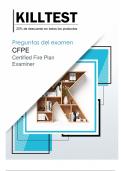CFPE
Certified Fire Plan
Examiner
,1.What is the maximum heat release rate of a single fuel package containing foamed
plastics that is part of an exhibit booth'?
A. 50 kW
B. 75 kW
C. 100 kW
D. 150 kW
Answer: C
Explanation:
According to NFPA 1031, which covers the qualifications for professionals in fire
safety and code compliance, specific requirements exist for fire protection systems,
including materials used in exhibit booths. In situations where foamed plastics are
part of an exhibit booth's construction, the maximum allowable heat release rate of a
single fuel package is 100 kW.
E
FP
This value aligns with the guidance provided to ensure that exhibit booths constructed
C
A
with foamed plastics do not exceed safe fire load limits, thereby reducing the risk of
FP
N
fire propagation in exhibition settings. By maintaining the heat release rate at or below
en
m
xa
100 kW, fire protection professionals can manage fire hazards effectively, ensuring
E
su
compliance with safety regulations as outlined in NFPA 1031.
ar
No exact references to the NFPA 1031 standard were found in the provided
ob
pr
documents. This information, however, is consistent with general fire protection
A
ra
pa
principles concerning maximum heat release rates in fire prevention codes.
se
For exact chapter and section references, a direct examination of the most current
re
pá
NFPA 1031 standard should be conducted.
re
-P
E
FP
C
en
2.How many fire hydrants are located on the project site on plan L2?
m
xa
A. Zero
lE
de
B. One
as
nt
C. Two
gu
re
D. Three
P
es
Answer: B
or
ej
Explanation:
M
s
La
NFPA 1031, Standard for Professional Qualifications for Fire Inspector and Plan
Examiner, does not provide specific details regarding the number of fire hydrants on a
specific project site or plan. NFPA 1031 outlines the qualifications and job
performance requirements for professionals, such as Fire Plan Examiners,
responsible for reviewing fire protection systems and ensuring code compliance. For
determining the number of fire hydrants on a project site as indicated on plan L2, you
will need to reference the specific project documents or site plans, which are not
included in the provided files. A Fire Plan Examiner, according to NFPA 1031, would
need to review the site plans, including plan L2, to identify the number and locations
of fire hydrants. The examiner uses skills and knowledge, as defined in NFPA 1031,
to evaluate and ensure the plans meet the required fire protection standards and
,codes, including ensuring adequate fire hydrant placement for fire safety and
emergency access. If further details or clarification about specific project documents
are needed, consulting the actual site plan or reaching out to the relevant authorities,
such as the local fire marshal or project manager, would be essential.
3.What is the occupancy classification of a restaurant, if it has an occupant load
greater than 50 people?
A. Business
B. Kitchen
C. Mercantile
D. Assembly
Answer: D
E
FP
Explanation:
C
A
According to NFPA 101, Life Safety Code, and NFPA 5000, Building Construction and
FP
N
Safety Code, a restaurant with an occupant load greater than 50 people is classified
en
m
xa
as an "Assembly" occupancy. An Assembly occupancy is defined as an occupancy
E
su
used for a gathering of 50 or more persons for deliberation, worship, entertainment,
ar
eating, drinking, amusement, awaiting transportation, or similar uses. Since the
ob
pr
restaurant has an occupant load greater than 50 people, it falls under this category.
A
ra
pa
For exact details, refer to NFPA 101 (Life Safety Code), Chapter 3, and NFPA 5000
se
(Building Construction and Safety Code).
re
pá
re
-P
E
FP
4.Which one of the following is a right given to a board of appeals?
C
en
A. The right to waive code requirements
m
xa
B. The right to set jurisdiction precedent
lE
de
C. The right to withdraw a project
as
nt
D. The right to grant alternative methods
gu
re
Answer: D
P
es
Explanation:
or
ej
The board of appeals does not have the authority to waive code requirements, set
M
s
La
jurisdiction precedent, or withdraw a project. However, according to NFPA 1031, the
board of appeals is typically granted the right to consider alternative methods or
materials to those required by code, provided that they achieve the same level of
safety. This is done to allow flexibility in the application of the code while maintaining
safety and compliance.
The exact provisions for the board of appeals can be found in NFPA 1031 and the
relevant local building and fire codes.
5.Exhibit.
, E
FP
C
A
FP
N
en
m
xa
E
su
ar
ob
pr
A
ra
pa
se
re
pá
What is the residual pressure according to the water supply graph?
re
-P
A. 20 psi (138 kPa)
E
FP
B. 42 psi (290 kPa)
C
en
C. 80 psi (552 kPa)
m
xa
D. 120 psi (827 kPa)
lE
de
Answer: B
as
nt
Explanation:
gu
re
To determine the residual pressure from the provided water supply graph, locate the
P
es
appropriate point on the graph where the flow rate intersects with the pressure line.
or
ej
According to the graph, the residual pressure is around 42 psi (290 kPa), which
M
s
La
matches option B. This value is determined by reading the vertical axis (pressure) at
the point where the flow test results are plotted. The pressure reading corresponds to
the data point on the dashed line provided in the water flow test summary sheet.
For detailed calculations, understanding, and verification, reference to NFPA
standards, particularly those related to water flow testing, such as NFPA 13 or NFPA
25, would be necessary.
6.Fire department access roads shall extend to within what distance of a single
exterior door providing access to the interior of a building?
A. 20 ft (6 m)




